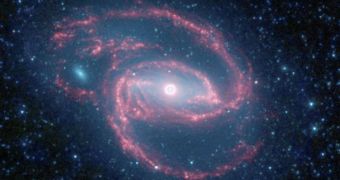In a recent series of observations, experts took a closer look at the central regions of the galaxy NGC 1097, and managed to gain a better understanding of the supermassive black hole that lies within.
The galaxy, which is located some 50 million light-years away, is protected from visible view by clouds of hydrogen gas and cosmic dust, but it can be observed in the infrared portion of the electromagnetic spectrum, experts say.
The recent studies were conducted using the NASA Spitzer Space Telescope, which is capable of seeing very far away with extreme precision. The telescope managed to reveal to astronomers that the supermassive black hole at the core of the target galaxy weighs some 100 million solar masses.
For comparison, a similar structure at the core of the Milky Way only weighs a few million solar masses. Around the black hole in NGC 1097, experts discovered a massive ring of stars.
In fact, the entire galaxy looks peculiar, as evidenced by the new image. Its spiral arms are extended heavily outwards, and they mostly contain red stars. This means that the objects are very old.
“The fate of this black hole and others like it is an active area of research. Some theories hold that the black hole might quiet down and eventually enter a more dormant state like our Milky Way black hole,” explains researcher George Helou, quoted by Daily Galaxy.
The expert holds an appointment as the deputy director of the NASA Spitzer Science Center (SSC), which is based at the California Institute of Technology (Caltech), in Pasadena. SSC astronomer Kartik Sheth adds that the star ring is an area of intense stellar formation.
“The ring itself is a fascinating object worthy of study because it is forming stars at a very high rate,” he explains. This most likely happens because hydrogen gas in the ring is being stirred up by the black hole around which it orbits.
The new observations again brought the issue of black hole growth into the spotlight. This field of research is still relatively new, and astronomers are struggling to find data that they could use as indicators in establishing how the growth process occurs.
“There is no theoretical upper limit” to black hole growth, explains University of Texas in Austin (UTA) expert Craig Wheeler. Factors that influence growth include the availability of matter around the object during its earliest days, and the speed at which this material was gobbled up.

 14 DAY TRIAL //
14 DAY TRIAL //